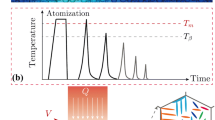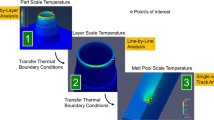Abstract
We present a meshfree direct numerical simulation (DNS) capability for the additive manufacturing (AM) process of metals based on the hot optimal transportation meshfree (HOTM) method. The HOTM method is a meshfree thermomechanical Lagrangian computational framework for material behaviors under extreme thermomechanical loading conditions. It combines the optimal transportation meshfree (OTM) method and the variational thermomechanical constitutive updates. In the HOTM method, the linear momentum and energy conservation equations are solved simultaneously in a monolithic way. A phase-aware constitutive model is developed to predict the melting/solidification phase change of metals and multiphase mixing during the AM process automatically. The HOTM method is validated in the simulations of the laser welding process over Inconel 625 bare plate by applying heat flux models for the laser beam, the convective heat loss, and radiation heat loss. The performance measurements of the simulation results, including the melt pool geometric dimensions and cooling rates, are comparable to the experimental data measured in the AM benchmark tests. The influence of various laser powers and laser scanning speeds on the melt pool thermodynamics is also studied.









Similar content being viewed by others
References
Griffith ML, Keicher DM, Atwood CL, Romero JA, Smugeresky JE, Harwell LD, Greene DL (1996) Free form fabrication of metallic components using laser engineered net shaping (LENS). In: Solid Freeform Fabrication Proceedings, vol. 9, pp. 125–131
Thijs L, Verhaeghe F, Craeghs T, Van Humbeeck J, Kruth JP (2010) A study of the microstructural evolution during selective laser melting of Ti–6Al–4V. Acta Mater 58(9):3303–3312
Wu AS, Brown DW, Kumar M, Gallegos GF, King WE (2014) An experimental investigation into additive manufacturing-induced residual stresses in 316L stainless steel. Metall Mater Trans A 45(13):6260–6270
Dinda GP, Dasgupta AK, Mazumder J (2009) Laser aided direct metal deposition of Inconel 625 superalloy: microstructural evolution and thermal stability. Mater Sci Eng A 509(1–2):98–104
Jia Q, Gu D (2014) Selective laser melting additive manufacturing of Inconel 718 superalloy parts: densification, microstructure and properties. J Alloys Compd 585:713–721
Yuan P, Gu D (2015) Molten pool behaviour and its physical mechanism during selective laser melting of TiC/AlSi10Mg nanocomposites: simulation and experiments. J Phys D Appl Phys 48(3):035303
Kubiak M, Piekarska W, Stano S (2015) Modelling of laser beam heat source based on experimental research of Yb:YAG laser power distribution. Int J Heat Mass Transf 83:679–689
Khairallah SA, Anderson AT, Rubenchik A, King WE (2016) Laser powder-bed fusion additive manufacturing: physics of complex melt flow and formation mechanisms of pores, spatter, and denudation zones. Acta Mater 108:36–45
Lane B, Heigel J, Zhirnov I, Khromschenko V, Ricker R, Phan T, Stoudt M, Mekhontsev S, Levine L (2019) Measurements of melt pool geometry and cooling rates of individual laser traces on IN625 bare plates. Integr Mater Manuf Innov
Yang Q, Stainier L, Ortiz M (2006) A variational formulation of the coupled thermo-mechanical boundary-value problem for general dissipative solids. J Mech Phys Solids 54(2):401–424
Li B, Habbal F, Ortiz M (2010) Optimal transportation meshfree approximation schemes for fluid and plastic flows. Int J Numer Methods Eng 83(12):1541–1579
Arroyo M, Ortiz M (2006) Local maximum-entropy approximation schemes: a seamless bridge between finite elements and meshfree methods. Int J Numer Methods Eng 65(13):2167–2202
Courant R, Friedrichs K, Lewy H (1967) On the partial difference equations of mathematical physics. IBM J Res Dev 11:215–234
King WE, Anderson AT, Ferencz RM, Hodge NE, Kamath C, Khairallah SA, Rubenchik AM (2015) Laser powder bed fusion additive manufacturing of metals; physics, computational, and materials challenges. Appl Phys Rev 2(4):041304
Ganzenmüller GC, Steinhauser MO (2011) The implementation of smooth particle hydrodynamics in LAMMPS. Paul Van Liedekerke, and Katholieke Universiteit Leuven
Funding
This project is financially supported by the National Science Foundation (NSF/CMMI Career Award 1652839).
Author information
Authors and Affiliations
Corresponding author
Additional information
Publisher’s Note
Springer Nature remains neutral with regard to jurisdictional claims in published maps and institutional affiliations.
Rights and permissions
About this article
Cite this article
Fan, Z., Li, B. Meshfree Simulations for Additive Manufacturing Process of Metals. Integr Mater Manuf Innov 8, 144–153 (2019). https://doi.org/10.1007/s40192-019-00131-w
Received:
Accepted:
Published:
Issue Date:
DOI: https://doi.org/10.1007/s40192-019-00131-w




